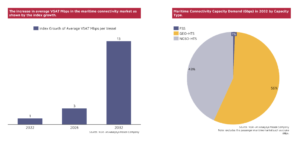Is NGSO the missing link for maritime digitalization 4.0?
The emergence of maritime 4.0 in tandem with the fourth industrial revolution underscores the objective of leveraging maritime data to improve operational and financial metrics. For mariners their objective is to minimize the CAPEX and OPEX through digitalization of operations. Satellite operators and service providers can aid this effort by increasing bandwidth per vessel. While gaining recent attention, NGSO solutions such as SES mPower, Starlink and OneWeb today, and Amazon Kuiper tomorrow alone will not solve all maritime digitalization challenges. Instead, a multi-dimensional network mix will be required, optimizing CAPEX and OPEX.

NSR’s Maritime Connectivity 11th Edition, projects a 3x growth in average VSAT Mbps per vessel by 2026, and 13x growth by 2032, excluding passenger vessels. As maritime end-users look to deploy the “office at sea” and increase their “digitalization of operations” both efforts will drive demand for higher connectivity requirements over the next 10 years. Both GEO and NGSO connectivity providers have a key role in delivering an agile network with greater bandwidth for marine vessels. The maritime connectivity market is on the cusp of higher per-vessel bandwidth demand.
Growing digitization
Given that digitalization has become essential for enhancing customer experience and sustainability objectives, both GEO and NGSO providers are expanding bandwidth and making on-orbit changes. The recent acquisition of Inmarsat by ViaSat predominately expands their band diversity. This provides greater reliability and faster connectivity to their customers within maritime and other mobility markets. Such GEO providers are now moving towards a small GEO approach to address niche markets such as MSS L-band, used for safety and backup connectivity.
Meanwhile, NGSO providers are leveraging their MEO and LEO orbits to provide connectivity with low latency. NGSO easily integrates with vessel SD-WAN, as in the case of SpaceX’s Starlink. Its compact and lightweight hardware, in addition to the software integration capabilities of service providers, simplify the integration process. Consequently, mariners can leverage NGSO to improve real-time vessel monitoring and predictive maintenance, ultimately reducing their own OPEX costs.
Minimizing OPEX via CAPEX
As concerns over OPEX expenses continue to mount, vessel operators are focused on CAPEX strategies which increase OPEX savings such as onboard digitalization and connectivity. NGSO providers such as SpaceX Starlink are emerging as potential catalysts in facilitating maritime digitalization 4.0 within the industry. If measured by trial adoption announcements alone, SpaceX’s pricing strategy for Starlink has received positive reception as NSR tracks in its Starlink Maritime. New terminals and onboard connectivity infrastructure such as software defined networking are CAPEX challenges today which will unlock OPEX savings tomorrow.
Despite concerns regarding long-term durability, Starlink presents a source of low CAPEX connectivity. Service Providers must figure out how NGSO options like Starlink will fit into their longer-term strategies. NGSO offerings must build on and complement their existing GEO-focused investments. To illustrate, Marlink’s has strengthen its connectivity offering by incorporating SpaceX Starlink into its smart network solution. This integration seamlessly incorporates the satellite network into the digital infrastructure of their customers. This combined service will help alleviate network congestion and improve digitalization outcomes for end-users. All of this through increased CAPEX spends which aim to produce OPEX offsets for maritime end-users.
The Bottom Line
To meet data-heavy industry demands, satellite communication providers should maintain a suitable level of flexibility in their service offerings. Service providers are well-equipped to provide this flexibility. NGSO can optimize vessels over the long term but need additional connectivity paths to meet reliability concerns. NGSO is only one piece of the puzzle. New business and infrastructure models are needed to meet the demands of the next era of maritime digitalization.
